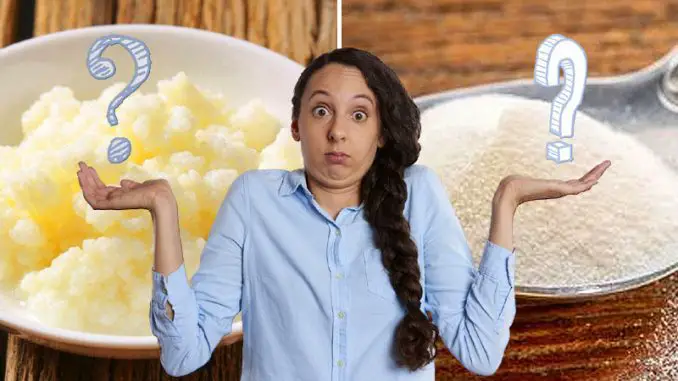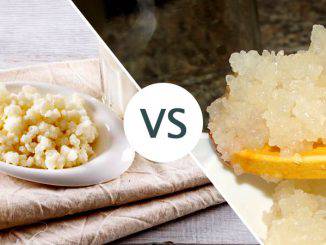
As we know, Kefir can be made in two ways and by using two different fermentation agents: Kefir grains and Kefir starters. Let’s see what’s the difference between these two methods, and what are their advantages and disadvantages.
What are Kefir grains?
Historically, the oldest and most widespread method of making Kefir is by using Kefir grains. These grains are a symbiotic colony of bacteria and yeast resembling small white cauliflower-like formations, held together by a polysaccharide called Kefiran. When immersed in any kind of dairy milk, they start to spread and ferment it. After a fermentation period of 12 to 24 hours, the milk turns into the famous and tasty yogurt-like product we call Kefir.
The easiest (and cheapest) way to obtain Kefir grains is to get them from a fellow Kefir user. As Kefir grains tend to multiply with each brew of Kefir, all of its users sooner or later find themselves in excess of grains. However, if you don’t have a Kefir user in your neighborhood, you can also buy Kefir grains from online stores like Amazon.
This entire website is dedicated to Kefir, so you can find here plenty of information about it, including how to make Kefir at home, what are Kefir’s benefits and precautions to take, how to handle and store it, as well as useful hints on how to prepare better Kefir, and more …
So, let’s move forward …
What are Kefir starters?
Another way to make Kefir at home is by using the so-called Kefir starters. These starters, also known as Kefir starter cultures, emerged just recently and are relatively less widespread than the Kefir grains.
Kefir starters (a.k.a. starter cultures) are powdered lyophilized (freeze-dried) cultures obtained from Kefir grains. These starters are usually intended for single-use and, unlike Kefir grains, do not multiply and are not reusable.
The preparation of Kefir with starter cultures can’t be any simpler: you just add the powdered starter to the recommended amount of milk and your kefir will be ready after roughly 12 hours. No need to strain it, stir it, or double-ferment it.
Another advantage of Kefir starters is that the resulting product has a more consistent quality and its taste is more predictable. That’s why most industrial methods of preparing Kefir normally use Kefir starters instead of grains.
However, Kefir starters also have some serious disadvantages, so let’s dig deeper into Kefir grains’ and Kefir starters’ pros and cons.
Grains & Starters: differences, advantages, and disadvantages
Let’s first remind that Kefir grains are natural colonies of living creatures (bacteria and yeasts) that, when regularly fed with milk (milk’s lactose), constantly multiply and can live practically forever.
Once you get your Kefir grains from a neighbor or buy them from an online store, you can keep on making Kefir for years.
Unlike Kefir grains, Kefir starter cultures are industrial products obtained through a process called lyophilization, or freeze-drying.
Lyophilization, also known as freeze-drying or cryodesiccation, is a process in which the product gets deeply frozen under very low pressure. Because of the low pressure, the water in the deeply frozen product quickly evaporates leaving the product almost completely desiccated (all moisture gets removed).
Lyophilization is nowadays a powerful tool in pharmaceutics, food processing, and the main method of providing food to astronauts.
However, lyophilization, or freeze-drying, also has its downsides. As you may presume, not all bacteria can survive extremely low temperatures and low pressure (vacuum) during the lyophilization process. This is the reason why most Kefir starters contain considerably fewer living probiotic bacterial strains than Kefir grains.
Even producers and resellers of Kefir starters confirm that the starter cultures may roughly contain 7 to 9 bacterial strains, while most of the Kefir grains are known to contain up to 50 different types of probiotic bacterial strains. So, Kefir made with grains will have more probiotic powers than the one made with Kefir starter cultures.
Additionally, as we already said, Kefir starters are intended for single use only. You will need a new dose of Kefir starter with each new batch of Kefir.
The main advantage of Kefir starters is that they are easier and simpler to use. They require no ‘maintenance’, and you don’t need to continuously make Kefir so as to keep your grains alive. The main disadvantage of Kefir grains is that to survive, they need to be constantly fed or, in other words, to stay constantly immersed in fresh milk. On the opposite, Kefir starters can stay in your cupboard or refrigerator for days or weeks until you need them to make your next batch of Kefir.
Unlike Kefir starters, Kefir grains are not only reusable but also multiply with repetitive use. After a couple of brews, your Kefir grains will most likely double in size and allow you to share a part of them with another Kefir user.
So, price-wise, while Kefir grains may look more costly upfront, they are not only richer in probiotics but also turn out to be more efficient, since they may support your homemade Kefir production for years.
Summary
Kefir can be made in two ways and by using two different fermentation agents: Kefir grains and Kefir starters. Kefir grains are living symbiotic colonies of bacteria and yeasts, while Kefir starters are lyophilized (freeze-dried) powders made of bacterial extracts.
While Kefir grains are packed with more probiotics and are reusable, they need more attention as they need to be constantly fed with fresh milk to survive.
Quite the opposite, Kefir starters are easier to handle and do not require any special care. However, they contain considerably fewer probiotic bacteria than Kefir grains and are intended for single-use only.
Pros & Cons:
Kefir grains pros:
- Have more probiotic powers than Kefir starters
- Are reusable and can support your Kefir production indefinitely
- Tend to constantly multiply, expanding your Kefir production capabilities and allowing you to share grains in excess with friends
- Stronger taste and more pronounced flavor
Kefir grains cons:
- Need more attention as they require continuous back-to-back production of Kefir
Kefir starters pros:
- Simple to use, handle, and store
- Provide more consistent quality and milder taste
Kefir starters cons:
- Have less probiotic powers than Kefir grains
- Intended for single-use only (not reusable)
My personal choice?
Well, as a long-time Kefir addict, I’d definitely prefer Kefir grains. Apart from being more price-efficient, they provide more probiotics and have a stronger and more pronounced taste.
Still, Kefir starters could be a better choice for people looking for simpler handling and a milder and consistent taste.
Related questions
- Is it true that some Kefir starters could still be reusable? This is only partially true. Indeed, in some cases, you could use a portion of your ready Kefir (made with Kefir starter) to inoculate your next batch of Kefir. Unfortunately, with each new batch, the activity of Kefir’s bacteria weakens and finally they are no longer able to ferment the milk. This method can be applied only a few times.
- Does all that’s said about Milk Kefir grains and starters also apply to Water Kefir? Yes. While Milk Kefir and Water Kefir are very different products, all that has been said about the difference between Milk Kefir grains and starters also applies to Water Kefir grains and starters.
Related resources
- What is Milk Kefir?
- The #1 reason why Kefir is good for you
- 3 easy tricks for a better Kefir
- Common myths about Milk Kefir
- Top 3 most common mistakes with homemade Kefir
- Why Kefir separates?
- Can Kefir be stored in the fridge?
- Most frequently asked questions about Kefir
- How to store the Kefir grains?
- Kefir benefits
- Kefir pros and cons



